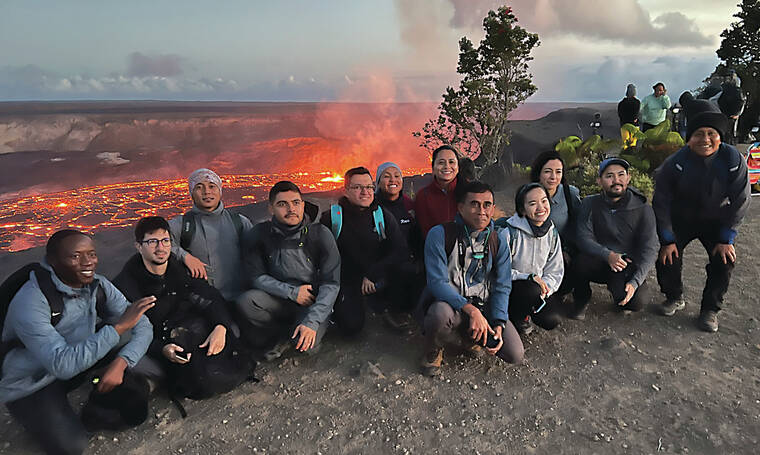The Center for the Study of Active Volcanoes (CSAV) is holding its annual summer International Training Course in Volcano Hazards Monitoring. This year is the 30th course since its inception in 1990 after a three-year hiatus due to the COVID pandemic. The training course is a product of the partnership between the University of Hawaii at Hilo, the University of Hawaii at Manoa, the USGS Hawaiian Volcano Observatory (HVO), and the USGS Volcano Disaster Assistance Program (VDAP).
Participants are scientists and technicians working at volcano observatories in developing countries with active volcanoes that threaten populated areas. This year, our 12 participants have traveled to Hawaii from the Philippines, Indonesia, Peru, Chile, the Democratic Republic of Congo, Colombia, Costa Rica and El Salvador.
Andrea Aguillar, a geophysicist from Chile, said, “After three years of waiting I’m finally here, directly from Coyhaique from Chilean Patagonia, happy to learn from the instructors and my colleagues … Everything I learn here will be useful for what we do as a country and without a doubt this experience will be the most enriching that I will have in my training as a professional and it will be worth being away from my son for so many weeks.”
The eight-week course begins on the island of Hawaii, where participants learn techniques HVO uses to monitor shield volcanoes and the hazards associated with Hawaiian-style eruptions. According to Juan José Idárraga, a geologist in Colombia, “The CSAV international course is the best experience that every volcanologist wants to have. I’ve been waiting for the course for some years and it is absolutely worth it. We have seen and learned amazing things just in a week. This course gives us the opportunity to learn from the best scientists and in the best natural laboratory: Hawaiian volcanoes.”
The CSAV International Training Course provides an invaluable natural laboratory for studying volcanic eruptions due to the frequent activity on Kilauea. Dave Rivera, a research specialist from the Philippines says, “Three years in the making and finally we’re here. It was definitely worth the wait to finally see the famous Hawaiian volcanoes we only see in textbooks, plus a warm welcome by Pele.”
The timing for the course was perfect because three days into the program, a spectacular eruption within Halema‘uma‘u crater began. CSAV International participants were able to examine the eruption safely from Uekahuna bluff, where they viewed the distant lava lake and fountains within Hawaii Volcanoes National Park during the first day of the eruption. The group had been anticipating the eruption after observing increased seismic activity on Kilauea.
Most participants work on volcanoes that can generally erupt more explosively than volcanoes in Hawaii. So, after six weeks of hands-on field and lab work in Hawaii, the group travels to the USGS Cascades Volcano Observatory (CVO) to spend two weeks working with VDAP.
There they will conduct field work to observe geologic hazards such as fast-moving lahars (mud/debris flows) and pyroclastic flows associated with more explosive volcanoes such as Mount St. Helens.
Wahyu Kusuma, a volcano observer from Indonesia, says a “big thanks for all of the best instructors. In my few days here, I learn so much.” Besides learning from highly dedicated course instructors, CSAV participants also learn from one another and build invaluable connections with other scientists.
Many challenges exist in volcano hazard monitoring, as no two volcanoes or eruptions are identical. CSAV International Training Course participants return home not only familiar with modern monitoring techniques but also with a network of scientific experts and contacts at partner organizations to communicate and share ideas about eruption forecasting and hazard mitigation. You can read more about the CSAV International Training Course here: https://hilo.hawaii.edu/csav/international/.
Volcano
activity updates
Kilauea is not erupting. Its USGS Volcano Alert level is ADVISORY.
Active lava has not been visible within Halema‘uma‘u crater at the summit of Kilauea since June 19. Earthquake activity in the summit region has been low over the past week. Summit tiltmeters showed gradual inflation for much of the past week. A sulfur dioxide (SO2) emission rate of approximately 135 tonnes per day was measured on June 30
Mauna Loa is not erupting. Its USGS Volcano Alert Level is at NORMAL.
Webcams show no signs of activity on Mauna Loa. Seismicity remains low. Summit ground deformation rates indicate slow inflation as magma replenishes the reservoir system following the recent eruption. SO2 emission rates are at background levels.
There were three earthquakes with three or more felt reports in the Hawaiian islands during the past week: a M3.0 earthquake 12 km (7 mi) SSW of Honokaa at 36 km (22 mi) depth on July 4 at 4:27 a.m. HST, a M3.0 earthquake 3 km (1 mi) SSW of Pahala at 35 km (21 mi) depth on July 3 at 10:32 a.m. HST, and a M3.4 earthquake 15 km (9 mi) S of Paauilo at 18 km (11 mi) depth on June 30 at 2:23 p.m. HST.
HVO continues to closely monitor Kilauea and Mauna Loa.
Please visit HVO’s website for past Volcano Watch articles, Kilauea and Mauna Loa updates, volcano photos, maps, recent earthquake information, and more. Email questions to askHVO@usgs.gov.



